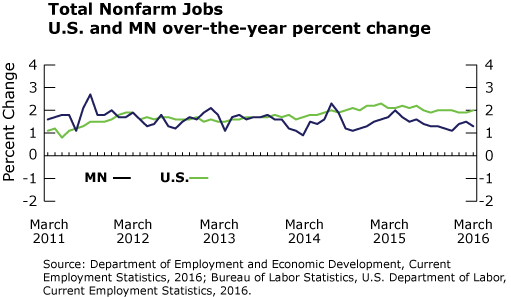by Nick Dobbins
April 2016
Monthly analysis is based on unadjusted employment data.
Employment in the Minneapolis-St. Paul MSA increased by 4,694 (0.2 percent) in March. The end of winter brought employment increases in Leisure and Hospitality (up 2,994 or 1.7 percent) and Mining, Logging, and Construction (up 929, 1.4 percent). Financial Activities also added jobs, up 1,235 (0.8 percent), on the month. Government employment, on the other hand, dipped in March. Its employment was down 1,541 (0.6 percent), primarily from a loss of 1,327 jobs (0.8 percent) in Local Government employment, which was split relatively evenly between educational and non-educational services. Annually, employment in the metro area was up by 33,925 jobs (1.8 percent). Information remained the only supersector to lose employment on the year, down 53 jobs (0.1 percent). Some of the sharpest increases came in Educational and Health Services and Leisure and Hospitality, both of which grew by 3.6 percent for the year, adding 11,386 jobs and 6,021 jobs, respectively. Health Care and Social Assistance, a component of the Educational and Health Services supersector, actually added more jobs, 9003, than any supersector save its parent. As a testament to the sector’s size, that accounted for only a 3.4 percent change in its employment. The other component sector, Educational Services, added just 2,383 jobs, although that represented a 5.2 percent change in its annual employment.
The Duluth-Superior MSA added just 48 jobs (0 percent) in March. This flat growth was the result of limited movement in most of the MSA’s supersectors. The only supersectors with a monthly change of more than 0.4 percent were Mining, Logging, and Construction (up 74 jobs or 1 percent), Other Services (up 62 jobs or 1 percent) and Information (down 10 jobs or 0.7 percent). Annually, employment in Duluth was down by 2,592 jobs (1.9 percent) as the job market in the area continued to struggle. March was the eighth straight month of over-the-year jobs losses for Duluth, and it was the only MSA in the state to show an annual decline in employment. The losses are generally concentrated in the area’s goods producing industries, with Mining, Logging, and Construction losing 872 jobs (10.2 percent) and Manufacturing losing 719 (9.7 percent). However, the picture isn’t all bad for the area, as the 1.9 percent over-the-year decline is an improvement over February’s 2 percent annual decline, as well as the recent low-point, November’s 2.9 percent annual decline.
Employment in the Rochester MSA was up in March, adding 592 jobs (0.5 percent) over February estimates. Notable growth occurred in Mining, Logging, and Construction (up 83 jobs or 2.2 percent), Professional and Business Services (up 178 jobs or 3.3 percent), and Leisure and Hospitality (up 155 jobs, 1.7 percent). The Information, Financial Activities, and Educational and Health Services supersectors all lost employment, although each shed fewer than 100 jobs, and only Financial Activities (down 15 jobs or 0.6 percent) lost more than one-half of 1 percent of its employment. Annually, employment in the Rochester MSA was up by 2,408 jobs (2.1 percent). Among the notable increases were Mining, Logging, and Construction, which added 269 jobs (7.5 percent), Trade, Transportation, and Utilities, which added 630 jobs (3.6 percent), and Educational and Health Services, which added 1,864 jobs (4.1 percent). Leisure and Hospitality stands out among the job-losers, off by 320 (3.3 percent) from March of 2015.
The St. Cloud MSA lost 190 jobs (0.2 percent) in March, largely caused by a drop of 312 (1.4 percent) in Trade, Transportation, and Utilities. That loss was driven primarily by a steep decline in one of its component sectors, Retail Trade, which shed 285 jobs or 2.2 percent on the month. The largest monthly increase came in Mining, Logging, and Construction, which added 126 jobs (2.2 percent) for the month. Over the year St. Cloud added 2,012 jobs (1.9 percent). Among the notable growth areas Educational and Health Services added 794 jobs (3.8 percent), and Professional and Business Services added 405 (4.8 percent).
Employment in the Mankato-North Mankato MSA was largely flat in March, losing 5 jobs (0 percent) from February estimates. Goods Producers lost 85 jobs (0.9 percent) while Service Providers added 80 (0.2 percent). Government employment was up by 20 (0.2 percent) for the month. Annually, the Mankato MSA added 760 jobs (1.4 percent). All of that gain came from Service Providers who added 1,131 jobs (2.5 percent) to overcome the loss of 371 jobs (3.8 percent) among Goods Producers.
Employment in the Fargo-Moorhead MSA was up by 108 jobs (0.1 percent) in March. Mining, Logging, and Construction added the most jobs, up by 230 (2.9 percent), while Professional and Business Services lost the most jobs, down 187 (1.1 percent). Annually, the Fargo-Moorhead MSA added 2,416 jobs (1.77 percent). The increase came entirely from service providing industries, as Goods Producers lost 168 jobs (0.9 percent) thanks to a decline of 385 (3.8 percent) in Manufacturing employment. Employment among Service Providers was broad-based, with Trade, Transportation, and Utilities (down 69 or 0.2 percent) and Other Services (down 79 or 1.5 percent), the only service providing supersectors to lose employment.
Employment in the Grand Forks-East Grand Forks MSA grew in March as the area added 191 jobs (0.3 percent). The increase was driven in large part by growth in the Leisure and Hospitality supersector, which added 209 jobs (3.5 percent). The monthly growth was also enough to keep the MSA in the black for over-the-year jobs growth, as employment was up by 130 jobs (0.2 percent) over March of 2014.
